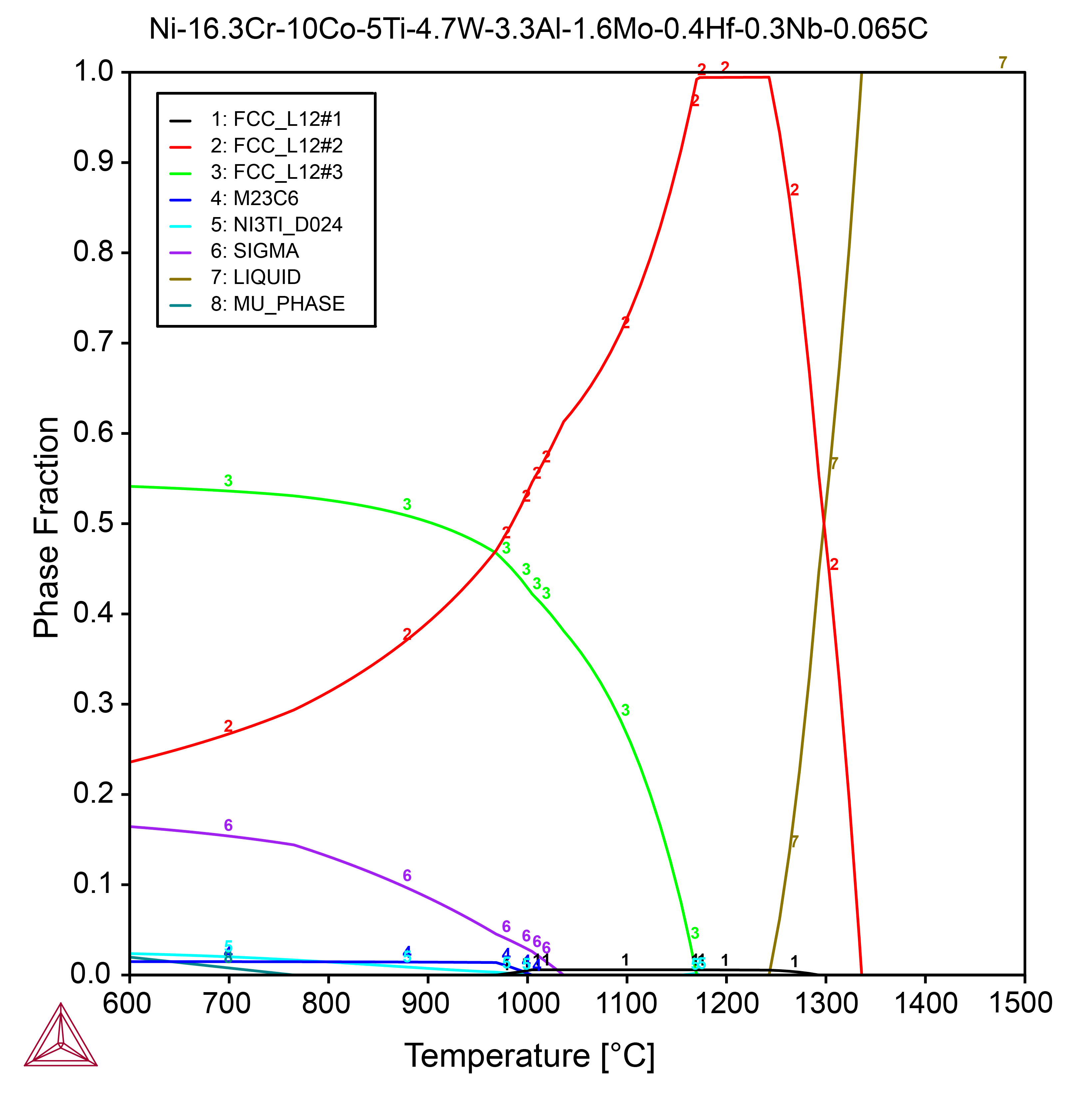Thermodynamic Modeling of the Sigma Phase
The sigma (σ) phase is an important Topologically Close-Packed (TCP) phase that is stable in many binary and ternary systems. Generally, the σ phase is undesirable due to its brittleness, which can be detrimental to the mechanical properties of Ni-based superalloys. In this context, computational thermodynamics within the CALPHAD framework plays a crucial role in predicting its stability, enabling researchers and engineers to avoid its formation during processing.
The TCS Ni-based Superalloys Database (TCNI) version 13 (TCNI13) is used in the calculations in this example. The results are more accurate than would be found with earlier versions of the database.
However, accurately describing the σ phase in multicomponent compositional space remains challenging due to its complex crystal structure and the extensive density functional theory (DFT) calculations required to assign reliable formation energies to its endmember compounds [2018Dup; 2024San].
In the TCS Ni-based Superalloys Database (TCNI) database, the Effective Bond Energy Formalism (EBEF), supported by DFT, is implemented to describe the σ phase (as well as the μ phase). The EBEF enables the use of the five-sublattice (5-SL) model, which more accurately reflects the crystallographic structure of σ [2018Dup; 2024San]. This approach significantly improves the description of these phases in binary and ternary systems, as well as across the multicomponent composition space.
Long et al. [2009Lon] report a cast Ni-based superalloy with the composition Ni–16.3Cr–10Co–5Ti–4.7W–3.3Al–1.6Mo–0.4Hf–0.3Nb–0.065C (in mass %), which was homogenized at 1100 °C and subsequently annealed at 843 °C. According to their findings, the homogenized microstructure consists of γ, γ′, and TiC, while the annealed microstructure also includes the η (Ni₃Ti_D0₂₄) and σ phases.
These experimental microstructures are well-predicted by the TCS Ni-based Superalloys Database (TCNI) database, as shown by the phase fraction plot.
Figure 1: Calculated phase fractions versus temperature of the Ni–16.3Cr–10Co–5Ti–4.7W–3.3Al–1.6Mo–0.4Hf–0.3Nb–0.065C (in mass %) alloy.
The only discrepancy is the prediction of the M23C6 phase, which was not observed experimentally. At 1100 °C, three FCC phases—corresponding to γ, γ′, and TiC—are predicted. Furthermore, the calculated phase compositions at 843 °C show good agreement with the experimental results reported by Long et al. [2009Lon] (see the table), particularly for the σ phase. This highlights the effectiveness of the EBEF approach in enabling accurate descriptions of TCP phases.
| Exp. - Long et al. [2009Lon] (mass %) | TCNI Database (mass %) | |||||||
|---|---|---|---|---|---|---|---|---|
| σ | Ni3Ti | γ | γ' | σ | Ni3Ti | γ | γ' | |
| Al |
- |
1.68 | 1.33 | 1.55 | <0.1 | <0.1 | 1.00 | 5.96 |
| Ti | 2.07 | 12.81 | 3.10 | 11.23 | <0.1 | 15.14 | 0.42 | 9.44 |
| Cr | 41.60 | 3.41 | 27.35 | 4.48 | 42.32 | <0.1 | 25.59 | 1.93 |
| Co | 13.41 | 7.15 | 13.56 | 7.30 | 14.81 | <0.1 | 13.78 | 6.52 |
| Ni | 23.52 | 69.31 | 49.12 | 71.92 | 20.85 | 69.61 | 51.19 | 74.21 |
| W | 12.64 |
- |
5.18 | 0.97 | 15.58 | <0.1 | 6.25 | 0.85 |
| Mo | 6.77 |
- |
2.77 | 0.52 | 6.43 | <0.1 | 1.69 | <0.1 |
| Hf |
- |
5.63 |
- |
2.01 | 0 | 14.29 | <0.1 | 0.44 |
Calculated phase compositions at 843 °C for the Ni–16.3Cr–10Co–5Ti–4.7W–3.3Al–1.6Mo–0.4Hf–0.3Nb–0.065C (mass %) alloy, compared with experimental results reported by [2009Lon].
References
[2009Lon] F. Long, Y. S. Yoo, C. Y. Jo, S. M. Seo, H. W. Jeong, Y. S. Song, T. Jin, Z. Q. Hu, Phase transformation of η and σ phases in an experimental nickel-based superalloy. J. Alloys Compd. 478, 181–187 (2009).
[2018Dup] N. Dupin, U. R. Kattner, B. Sundman, M. Palumbo, S. G. Fries, Implementation of an Effective Bond Energy Formalism in the Multicomponent Calphad Approach. J. Res. Natl. Inst. Stand. Technol. 123, 123020 (2018).
[2024San] J. C. P. Santos, S. Griesemer, N. Dupin, U. R. Kattner, C. Liu, D. Ivanova, T. Hammerschmidt, S. G. Fries, C. Wolverton, C. E. Campbell, Applying the Effective Bond Energy Formalism (EBEF) to Describe the Sigma (σ) Phase in the Co-Cr-Ni-Re System. J. Phase Equilibria Diffus. 45, 330–357 (2024).
